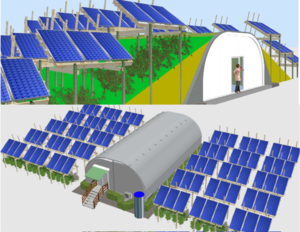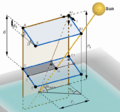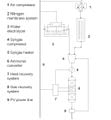
Local indoor farming plays a significant role in the sustainable food production sector. The operation and energy costs, however, have led to bankruptcy and difficulties in cost management of indoor farming operations. To control the volatility and reduce the electricity costs for indoor farming, the agrivoltaics agrotunnel introduced here uses: (1) high insulation for a building dedicated to vertical growing, (2) high-efficiency light emitting diode (LED) lighting, (3) heat pumps (HPs), and (4) solar photovoltaics (PVs) to provide known electric costs for 25 years. In order to size the PV array, this study develops a thermal model for agrotunnel load calculations and validates it using the Hourly Analysis Program and measured data so the effect of plant evapotranspiration can be included. HPs are sized and plug loads (i.e., water pump energy needed to provide for the hybrid aeroponics/hydroponics system, DC power running the LEDs hung on grow walls, and dehumidifier assisting in moisture condensation in summer) are measured/modeled. Ultimately, all models are combined to establish an annual load profile for an agrotunnel that is then used to model the necessary PV to power the system throughout the year. The results find that agrivoltaics to power an agrotunnel range from 40 to 50 kW and make up an area from 3.2 to 10.48 m2/m2 of an agrotunnel footprint. Net zero agrotunnels are technically viable although future work is needed to deeply explore the economics of localized vertical food growing systems.
See also[edit | edit source]


- Coal with Carbon Capture and Sequestration is not as Land Use Efficient as Solar Photovoltaic Technology for Climate Neutral Electricity Production
- Dual use of land for PV farms and agriculture literature review
- sheep
- Israeli white plastic reflectors
- A Farmer's Guide to Going Solar (NREL)
- German guidelines: https://www.ise.fraunhofer.de/content/dam/ise/en/documents/publications/studies/APV-Guideline.pdf
- 2021 review
- Miskin, C.K., Li, Y., Perna, A., Ellis, R.G., Grubbs, E.K., Bermel, P. and Agrawal, R., 2019. Sustainable co-production of food and solar power to relax land-use constraints. Nature Sustainability, 2(10), pp.972-980.
- Retrofitting solar parks for agrivoltaics
- Shading PV
- Alexis' talk at American Solar Grazing Association2021
In the News[edit source]
- Agrivoltaics: solar energy + better crops Climate and Nature
- Why solar power and farmers’ fields could be the perfect combination TVO
- Solar farms and sheep show the makings of a clean energy classic duo Business Renewables
- Agrivoltaics charge up St. Albert-area farms St Albert Gazette
- Sheep, solar and crops. How some Alberta farms are creating ideal growing conditions Western Wheel
- Sheep, solar and crops. How some Alberta farms create ideal growing conditions Voxpopuli
- 3D printed clamps for front-surface PV mounting on wood racking PV Magazine
- Harvesting the Sun to Grow in the Shade Garden Culture Magazine
- What crops fit with vertical agrivoltaics? PV Magazine
- Agrivoltaics – Keeping the farm in the solar farm Green Energy Futures






































